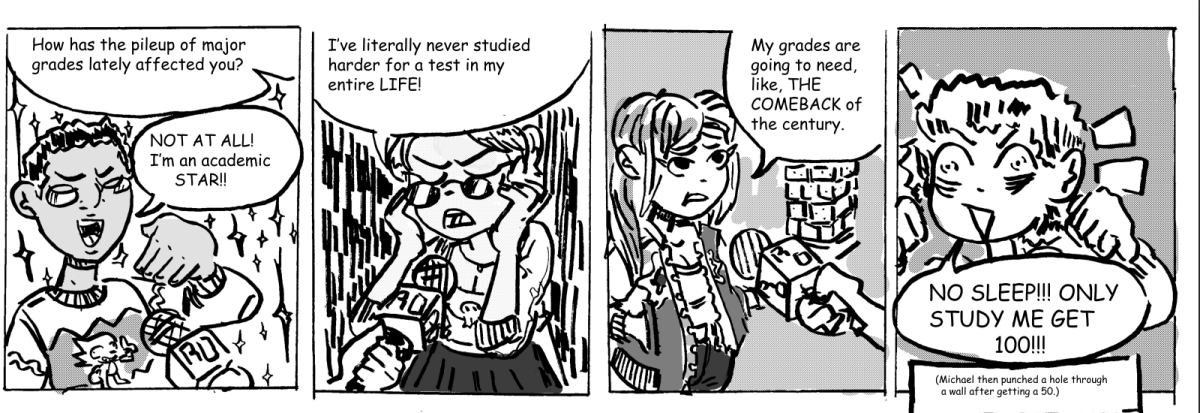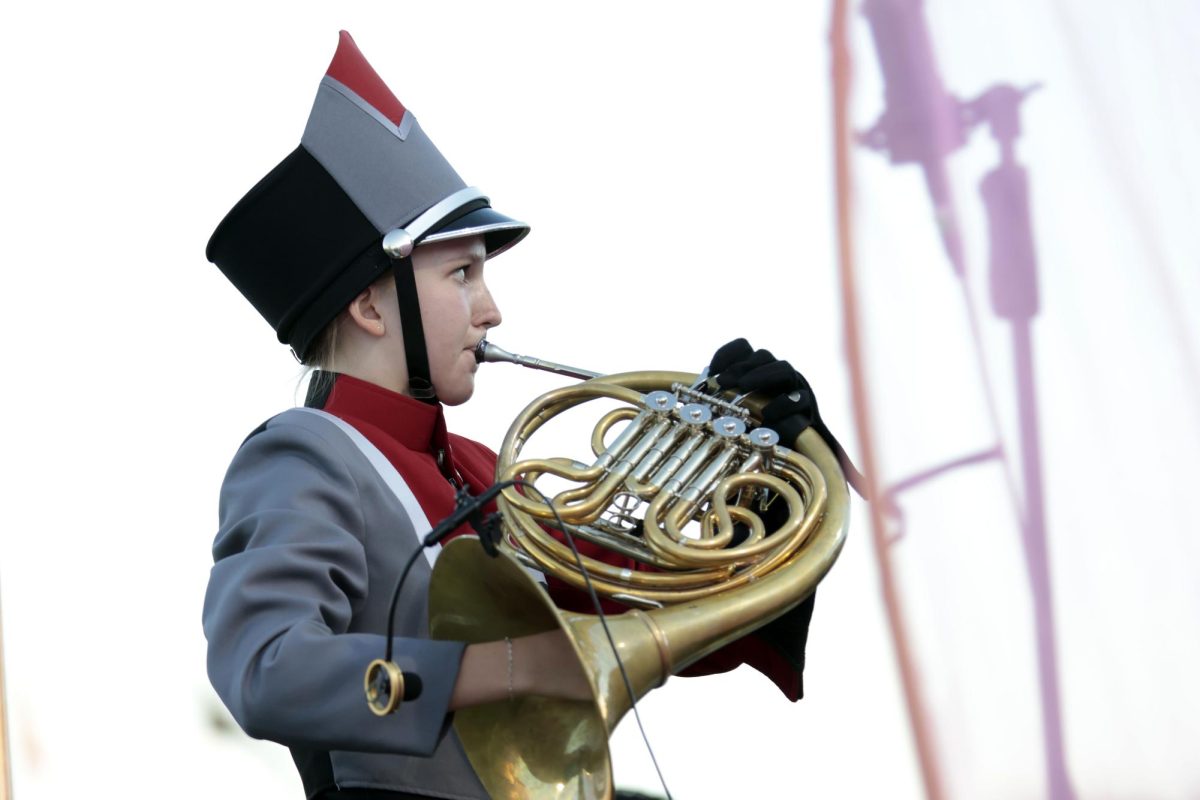From satirist Charlie Brooker, Black Mirror has finally reclaimed its throne with season four. The largely anticipated season four of technological horror anthology arrived on Dec. 29 with six new episodes. With all the hype, fans, including myself, were worried the new season would disappoint. Meeting expectations set by the fans would prove to be difficult, but it seems Brooker’s new set of episodes proved to be worth the wait.
Black Mirror serves to tantalize the viewer with a dystopian perspective of potential futures, usually centering around manifestations of popular technological trends. Everything from VR to Social Media is fair game for Black Mirror’s gaze.
I’m going to review each episode individually before I review the season as a whole. I’m writing this without reading any other review of the season/episodes (besides listening to friend’s vocal opinions) in order to stay unbiased and give my pure unfiltered opinion.
[MAJOR SPOILERS AHEAD FOR THE ENTIRE SEASON AND SERIES – SERIOUSLY DON’T SPOIL IT FOR YOURSELF.]
Episode 1: USS Callister
The season begins on the right foot with “USS Callister,” the ambitious, retro-feel, space episode. We follow Robert Daly, the shy developer behind the popular game “Infinity” in which users beam into a endless universe to explore and play. Daly is awkward, introverted and the butt of a lot of the jokes around the office. He’s the mastermind behind the game but he’s exploited and put down by Walton, the CEO. But Daly has a secret, he takes DNA from everyone who wrongs him and beams them into his own modified, singleplayer version of Infinity. These victims have the same consciousness as their real-life counterparts, made to be commanded/tortured by the tyrannical Daly.
“USS Callister” rose similar questions that my favorite episode, Season 2 Episode 4 “White Christmas,” brought about. Is a conscience the same thing as a life? What makes something alive? When Daly traps people inside of his game, they feel and think they’re alive, yet they’re just code on a computer. What makes their perception of reality and interactions different from our fleshy versions (except for the obvious ones and zeros that makes up their bodies). I love it when Black Mirror causes me to ask myself these sorts of questions, which is why I liked this episode.
The execution of this episode was top-notch. The retro-grade intro, the cast, the animation and effects, and even the costumes were just a joy to watch. The story of rebellion was nice and cute but it was actually one of my main problems with the episodes. When I watch Black Mirror, I want to be hopeless and scared. I’m not very fond of happy endings and the somewhat cheesy ending sort of ruined it for me in all honesty. Don’t get me wrong though, the episode is still very good and was done very well.
7.4/10
Episode 2: Arkangel
This was one of my favorite episodes of the season. A worried mother decides to put an implant called Arkangel in her daughter, Sara’s, head that allows the mother to monitor her daughter’s location, track her vitals, look through her eyes and filter out unpleasant sights. At first the implant seems to be positive, it makes young Sara’s life a little easier by blocking out scary things like barking dogs. The implant ended up saving Sara’s grandfather as well, when he had a heart attack. But as Sara grows up, she never saw things like blood, and so she starts cutting herself open. Her mom turns the implant off for awhile, but as Sara’s life continues, Sara’s mom has to grapple with turning the machine on and off as Sara engages in questionable activities.
This episode was really interesting in a similar way that Season 3 Episode 1 “Nosedive” was interesting. “Arkangel” critiques surveillance of minors and some of the adverse effects of such action. Sara grows up in a protected and comfortable world with the filters of Arkangel which causes Sara to become more susceptible to negative stimulus.
The episode epitomizes “helicopter parents” and how guiding someone’s life so forcefully can cause exactly what you don’t want to happen to occur. It creates an interesting paradox where the viewer has to question what character is in the right. Do you root for Sara, the rebellious youth who was controlled at such a young age or the tyrannical mother who only wants the best for her child? By posing questions as such, Arkangel cemented itself as an excellent episode of the season.
8.7/10
Episode 3: Crocodile
Crocodile was a very interesting episode, probably the most experimental episode (story-wise) of the season. It follows two storylines, one of renowned architect Mia Nolan, and one of a humble insurance agent named Shazia Akhand. It begins with a flashback of Mia in a car with a boyfriend at the time where they accidentally hit and kill someone in the mountains. They’re forced to hide the body due to the driver having alcohol in his system. Fifteen years later, Mia is successful and has a family. The old boyfriend (now an ex-boyfriend) visits Mia and tells her that his immense guilt is going to lead him to tell the victim’s wife the truth anonymously. Mia’s paranoia of being discovered and losing everything causes her to attempt to stop him and accidentally murder him. She’s forced to hide the body and pretend nothing happened. But there’s a catch, upon glancing out the window after the murder happened, Mia witnessed a driverless pizza delivery car hit a pedestrian. Shazia is the insurance agent who is doing the investigation on that very accident and she uses a machine that lets her watch people’s memories. This spells grave trouble for Mia and upon being caught, she kills Shazia and has to kill everyone Shazia is connected to.
I really enjoyed this episode because it was a massive trainwreck, of an almost Fargo sized magnitude. “Crocodile” dealt with memories and how they can be used against us. But it was more than that, it showcased how the desire and the preservation of success can manifest itself to madness. Mia doesn’t care about other people, her family, or even herself and only cares of her career.
“Crocodile” was really enjoyable but I probably would’ve enjoyed it more if it wasn’t an episode of Black Mirror. Don’t get me wrong, it definitely fits in with the theme and ideas of the show, but the way that it was filmed, how the technology wasn’t the primary focus, as well as the pacing of the episode, made it feel less like a Black Mirror episode. I would’ve loved to see it as a full time movie or something of that capacity.
8.1/10
Episode 4: Hang the DJ
This was my favorite episode of the entire season, and possibly the entire series. “Hang the DJ” follows two characters, Frank and Amy who appear to be in a sort of “camp” for dating that promises to find every participants’ “Ultimate Compatible Other” with the guidance of a 20Q-reminiscent wafer named “Coach”. Participants are put in relationships for an established amount of time in order for the systems to gauge the participants’ information. Frank and Amy are initially matched together but have an expiration date of 12 hours. They hit it off but separate and are matched with other people for a long time until they eventually rebel against system to find each other and escape only to discover, they’re a simulation to prove that the real life Amy and Frank work together.
The episode uses a viewer’s pre-established conceptions about film to prevent the viewer from questioning the origins of both characters, leading to the excellent plot twist at the end of the episode. Even though the idea of them being in a simulation was teased throughout the episode, you really don’t expect it. This plot twist is what really sold the episode for me, similar to the end of Season 2 Episode 4: “White Christmas”. Normally, I’m not fond of the feel-good episodes like the critically acclaimed Season 3 Episode 4 “San Junipero” but something about “Hang the DJ” was really special to me. I adored both characters of Frank and Amy, as well as their relationship together. Their relationship together felt natural to watch and it was enjoyable to watch the two of them evolve through their different partners. It was Kelly and Yorkie levels of adorable but the world they were put in was so interesting to explore and understand because there’s so little known at the beginning.
Beyond the simulation and plot twists, “Hang the DJ”’s main theme was about love and what it means to fall in love with someone. The episode explores horrible relationships, meaningless sexual interactions, and common relationship tropes. Whenever questioned by a participant, Coach answers hard questions with “everything happens for a reason”, a statement that contrasts Frank and Amy’s view on their relationship. Although it’s cheesy, “Hang the DJ” is represents the search for love in a modern era, the clash between trusting the system or trusting your heart. In the beginning of the episode, Frank represents someone who trusts in the system while Amy questions it. This is illustrated in their conversation in the gazebo where they walk through their unique perspectives. Once both of them have been matched with their “Ultimate Compatible Other” they meet again and wake up. Frank rejects the system and joins Amy in running away and the episode is really beautiful in that regard.
But there’s a dark inherent contradiction in this episode that’s difficult to see at first. “Hang The DJ” sets itself up to be story of rebellion against a system that tells you to love a specific person by breaking free and chasing your heart. Yet, this happens inside of a simulation designed to find you that specific person. So you break free and the system capitalizes on it. This sends a mixed message to the viewer, do we trust the system or do we break free? This dark contradiction fascinates me as much as it perplexes me.
9.3/10
Episode 5: Metalhead
I’ll come right out and say it: Metalhead was the most disappointing episode of Black Mirror I’ve ever seen. When the episode started in entirely black and white, I was instantly hooked. But as the episode progressed, I wasn’t impressed. The plot follows a group of people trying to survive in a post-apocalyptic wasteland and they encounter a small, dog-like, robot that begins to hunt them down. This was the goriest episode of the series but that’s is not the reason for my dislike of the episode, actually I’m quite fond of when television shows or movies aren’t afraid to be unfiltered. My dislike of the episodes is due to the simplistic plot, predictable characters and events, and the lack of inspiration in the episode.
Don’t get me wrong, it’s not a waste of 40 minutes, but when compared to the other episodes of Black Mirror, “Metalhead” falls flat. “Metalhead” makes an obvious commentary on robotic warfare because, even though, the origin story of the episode is mostly unknown, it seems to be some sort of military machine. This is an interesting concept of course but the way that “Metalhead” carries it out in a very uninspiring way. The group finds the machine. The group runs from machine. The machine kills the group. That’s it.
I have to blame myself a little bit for my disappointment, this episode was of course preceded by my favorite of the season “Hang the DJ” so my expectations were a little high but upon watching it again, my previous perspective on the episode did not change much.
Criticisms aside, “Metalhead” was still enjoyable to watch, the dog (the machine) hunting the group down was very entertaining (in a twisted sort of way). Like I said before, I watch Black Mirror to feel hopeless and I definitely felt that way watching this episode. Aesthetically, the black and white is really great and was honestly one of the most redeeming things about the episode.
6.6/10
Episode 6: Black Museum
The climax of season four didn’t disappoint with “Black Museum”. We’re first introduced to the character of Nish, a young girl who appears to be traveling cross country by car. The episode opens with Nish stopping in the middle of a desert-like plain at a deteriorated gas station in order to recharge her electric car. She notices a tourist trap called the Black Museum. She walks up and meets the curator, Rolo Haynes, and takes a tour. Rolo walks Nish and the viewer through an anthology of artifacts found within the museum walls and their stories.
I screamed out loud when Nish first walked through the museum because there were references and pieces from other Black Mirror episodes scattered throughout the museum on display. Not only was it exciting to see the mask from Season 2 Episode 2 “White Bear” again but these references signaled a connected universe. There have been small nods or easter eggs about past episodes in other seasons but nothing of this degree. Personally, I dislike the idea of a connected universe as I appreciate the nature of an anthology for Black Mirror, but the idea of a lowkey, connected subplot that is slowly revealing itself is exciting.
But the excitement doesn’t stop there. This episode was quite good and I really enjoyed watching it. It took a similar approach to (I keep mentioning this episode, apologies for sounding like a broken record) Season 2 Episode 4 “White Christmas” where the episode was structured as an anthology inside of an anthology episode. Rolo walks through three primary stories: The doctor who could feel his patients’ pain, the comatose woman stuck inside of her husband’s mind, and the death row inmate’s consciousness stuck in hologram form – sentenced to a lifetime of being electrocuted over and over again by museum attendees.
All of these stories were very good, to the point where I wish each had an episode of their own (disregarding how they play into the ending of the episode) but I appreciate that it was like three extra episodes in the six episode season. This method lead up to the grand finale of the big twist, tying together the tech used in the stories with the main character and Rolo leading to one of the most satisfying finales of a season.
8.5/10
The Season as a Whole
Season four of Black Mirror was no disappointment. Like I said before, I was worried that things would turn out poorly due to all the hype surrounding the new episodes but each episode stayed fairly true to the theme and feel of Black Mirror. That being said, there were some problems. Namely, the season felt too happy. The creators probably saw the immense success and acclaim of the episode “San Junipero” and created significantly more happy endings than any other season. This doesn’t necessarily take away from the episode but it does alter the overall theme of the series. Episodes like S1 E2 “Fifteen Million Merits”, S2 E2 “White Bear”, S3 E3 “Shut up and Dance” all instill a feeling of hopelessness to the viewer with the ending. This hopelessness is the most terrifying part of the show, the inability for the characters to do anything. This inability makes it easier to relate and feel with the characters because, like a viewer behind a television, the character can only watch as the events around them unfold. But with more happy endings, it mixes that up, seemingly make it so that these evils can be beaten. In that regard, Black Mirror is slowly transforming from a show that satirizes technology and warns against possible futures to a show that resembles a short story from a 1970s Popular Science magazine; action, adventure, and a victory.
If this transformation continues, we will have a much different show on our hands; just another anthology with a happy ending. For that, I hope to see more of that hopelessness in Season 5.
But don’t get me wrong, a happy ending is good every once in a while, for example, “Hang the DJ” was absolutely superb and had a happy ending (kind of, remember the dark contradiction that was mentioned earlier). More cheerful episodes will make the dark episodes darker and perhaps that was on the mind of the writers of this season. I only critique the abundance of the positive.
All in all, Black Mirror is still my favorite show and I’m excited to see where it’s going to go from here.
TL;DR: It’s really good, like really really good. Go watch it if you haven’t, go watch it again if you have. 8.1/10
















